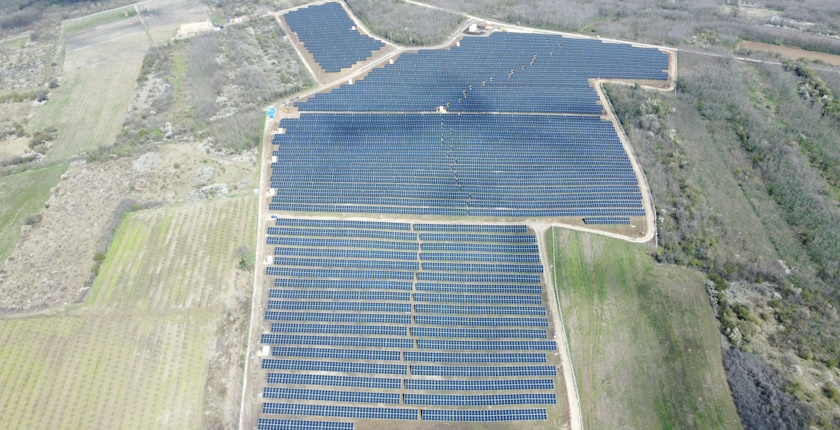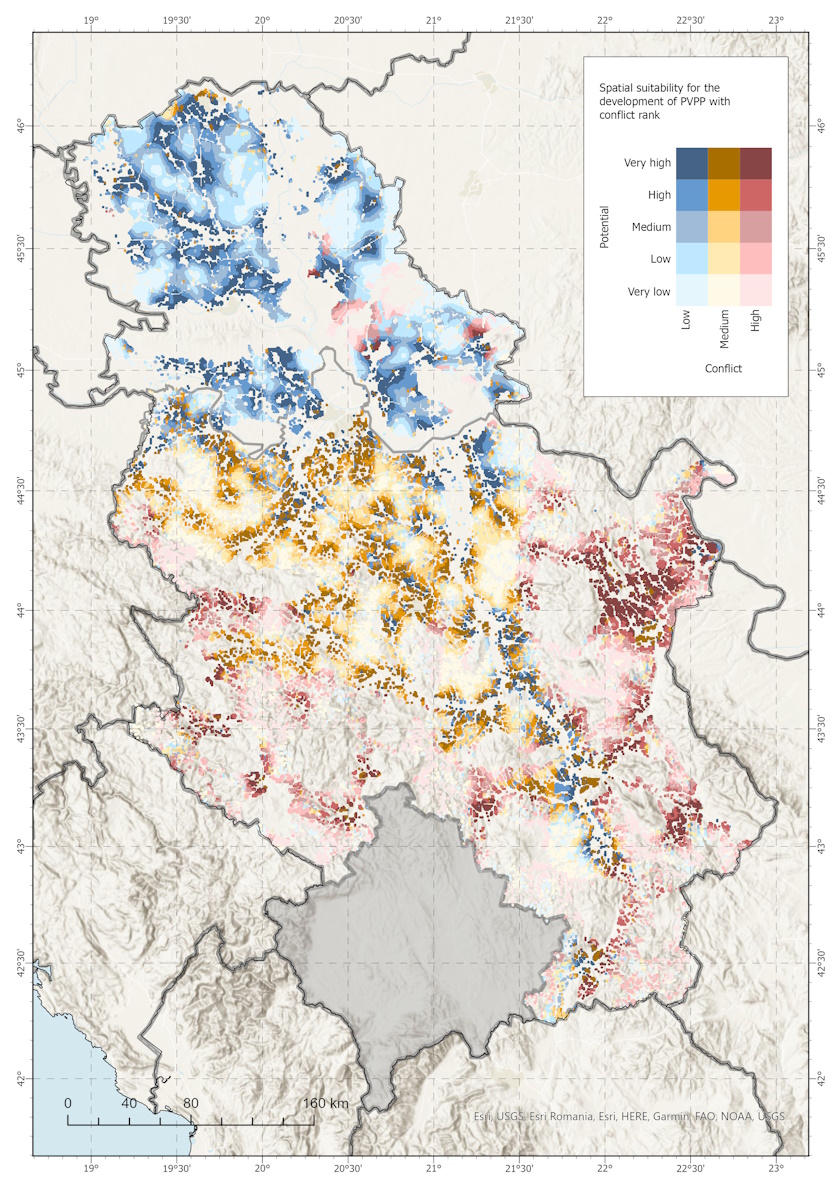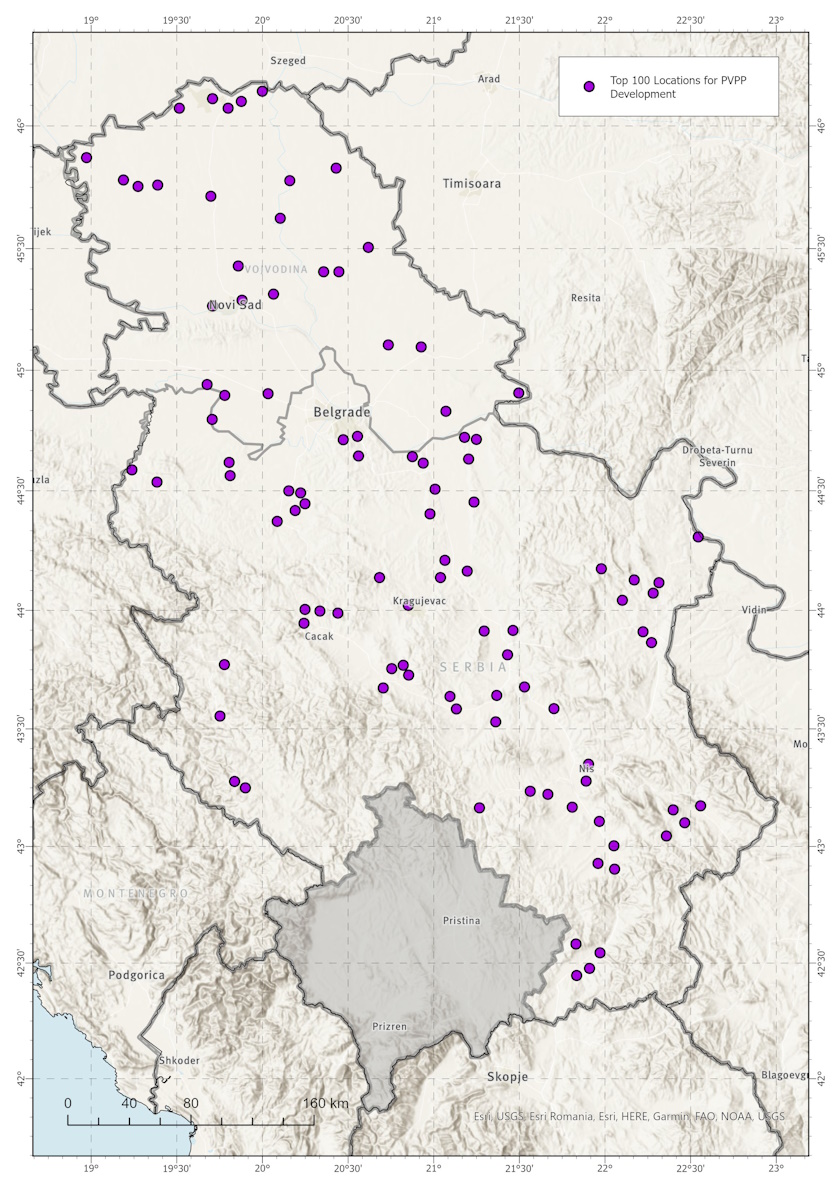
Photo: Igor Vejnović, The Nature Conservancy
Author: Igor Vejnović, The Nature Conservancy
Map of 100 sustainable locations for solar energy could meet 10% of annual household consumption
Serbia is currently facing an important decision about how its energy and climate future will look. Will the country take a significant step towards decarbonization and transition to a net-zero economy? To do so, Serbia will need to earmark land that can be used for renewable electricity generation, mainly from solar and wind resources.
The current efforts to reform and restructure the energy sector need to go hand in hand with spatial planning of electricity generation to avoid the consequences of climate change driven by the fossil fuel-dependent energy sector, without jeopardizing other strategic sectors such as agriculture, tourism, or natural resources such as protected areas or biodiversity. The cure shouldn’t be worse than the disease.

The area occupied by the solar plant doubles as a pasture for grazing sheep, reducing overall use of space.
I am writing this under AC while the outside temperatures across the Balkans are reaching 40 C. Without appropriate climate action we will increasingly face weather-related disasters such as heatwaves, droughts, fires, extreme rainfall, and floods. Freshwater ecosystems are especially vulnerable to these climate shocks. These extreme weather events do not simply come and go, they leave behind serious damage, as demonstrated by the June floods that led to a state of emergency being declared in 56 municipalities across Serbia.
The National Energy and Climate Plan (NECP) on public consultation
One of the ways to ensure that there is enough land is to conduct multisectoral and strategic planning of energy in space in alignment with other objectives that countries have such as food security or tourism development. Luckily, Serbia has a tool for that: as a signatory party to the Energy Community Treaty, Serbia is obligated to develop and adopt National Energy and Climate Plan (NECP), which serve as a crucial instrument for transitioning from fossil fuels to renewable energy sources. The goals, measures, and policies outlined in these integrated plans will define the pathway towards carbon neutrality.
The Ministry of Mining and Energy began drafting the National Energy and Climate Plan of the Republic of Serbia in April 2021, covering the period up to 2030 with projections up to 2050. Upon reviewing the Draft document, which is currently open for public consultation until July 28th, there are some positive signs. For instance, measure PM_D25 for “[u]pdating, simplifying and optimizing the spatial planning framework” is crucial to align energy with other use of space.
If this measure survives in the document’s final version, it could provide a basis for Serbia to designate Renewables Acceleration Areas – zones of high energy yield but low environmental and social impact where the permitting could be simplified and accelerated. Renewables Acceleration Areas are currently being piloted in EU member states as a part of RePowerEU: the flagship EU initiative to speed up the buildout of renewables and move away from imported fossil fuels. The Nature Conservancy is helping Croatia to create such areas. Serbia shouldn’t lag behind.
The current version of the NECP predicts an increase in their share from 33.6% to 2030. However, there seems to be some restraint as this decision does not align with the decision of the Ministerial Council of the Energy Community, which sets a national target for Serbia of 40.7% in terms of increasing the share of renewables.
The fact that there is room for increasing the share of renewable energy sources is confirmed by the data showing that the current total energy production from solar photovoltaic systems in Serbia is only at 0.04%. The NECP envisages an increase in the share of solar energy by 2030 to 1.73 GW under the more ambitious scenarios. Given that the renewable potential in Serbia is measured in tens of GW, and that the current project developer interest is up to 10.3 GW of proposed renewables projects, this objective seems limited in its aspiration.
The 100 best locations for solar power plants could provide 1 GW of energy
In order to contribute to the acceleration of renewable energy development, specifically solar photovoltaic power plants, The Nature Conservancy, together with the wider group of local partners, has launched the project “Smart Planning for Sustainable Development: Mapping Serbia’s Solar Potentials.” Besides aiming to facilitate faster development, the project’s task was to ensure that the implementation does not impact areas of valuable nature and spaces of great importance for human life and activities.

With an installed capacity of 9.9 MW in a low conflict area, it serves as a good illustration of what the 100 locations selected in the study would look like when developed.
The study, for which the methodology was developed by local experts in collaboration with The Nature Conservancy, explored conflicts and potential for the development of solar photovoltaic systems (PV). The result of the study is a map that combines both aspects (Map 1), as well as a selection of the 100 best locations for solar system development based on both criteria (Map 2), with an estimated installed capacity of 10 MW each.


To ensure even regional development, the study picked the four best spots in Serbia’s 25 regions to evenly spread solar plants. If these locations were utilised for electricity production using solar photovoltaic cells, the electricity generated would meet approximately 10% of Serbia’s total household consumption.

A sustainable future requires determination
The Government of Serbia has adopted a decree to select a strategic partner for installing 1 GW of solar power plants and at least 200 MW of battery storage. This study, offers a tool for decision-makers at the national, provincial, and local levels, independent expert institutions, investors, and the professional community to enable the best possible placement for those plants.
Our study has shown that Serbia has great potential for developing a more sustainable energy system. Through collaboration across different institutions and disciplines, we have proven that there is knowledge, experience and willingness to tackle this complex issue. We also hope that the National Energy and Climate Plan, which is due to be adopted in September, will endorse more ambitious renewable expansion scenarios, retain policies and measures that keep pace with the high demand from project developers, and firmly establish a date for Serbia’s shift to carbon neutrality.










Be the first one to comment on this article.